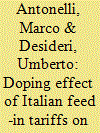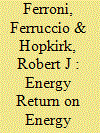|
|
|
Sort Order |
|
|
|
Items / Page
|
|
|
|
|
|
|
| Srl | Item |
| 1 |
ID:
104932


|
|
|
|
|
| Publication |
2011.
|
| Summary/Abstract |
Nuclear power and solar photovoltaic energy conversion often compete for policy support that governs economic viability. This paper compares current subsidization of the nuclear industry with providing equivalent support to manufacturing photovoltaic modules. Current U.S. indirect nuclear insurance subsidies are reviewed and the power, energy and financial outcomes of this indirect subsidy are compared to equivalent amounts for indirect subsidies (loan guarantees) for photovoltaic manufacturing using a model that holds economic values constant for clarity. The preliminary analysis indicates that if only this one relatively ignored indirect subsidy for nuclear power was diverted to photovoltaic manufacturing, it would result in more installed power and more energy produced by mid-century. By 2110 cumulative electricity output of solar would provide an additional 48,600 TWh over nuclear worth $5.3 trillion. The results clearly show that not only does the indirect insurance liability subsidy play a significant factor for nuclear industry, but also how the transfer of such an indirect subsidy from the nuclear to photovoltaic industry would result in more energy over the life cycle of the technologies.
|
|
|
|
|
|
|
|
|
|
|
|
|
|
|
|
| 2 |
ID:
128404


|
|
|
|
|
| Publication |
2014.
|
| Summary/Abstract |
In less than six years, Italy has become one of the leading markets for PV power plants and one of the countries in the world with the largest number of installations and installed peak power. Such a quick and large growth is due to a series of feed-in tariff schemes that have been uncapped until 2012. As a matter of fact, any size or any number of PV power plants could be installed during a period of three years.
Since the feed-in tariffs are not paid by national taxes but are charged on the electricity bills, Italian energy users are now due to pay each year a surcharge of 9 billion euros on their energy bills.
This paper aims at discussing this development by highlighting the benefits but also some significant drawbacks that the application of uncontrolled feed-in tariffs has produced.
|
|
|
|
|
|
|
|
|
|
|
|
|
|
|
|
| 3 |
ID:
150679


|
|
|
|
|
| Summary/Abstract |
Many people believe renewable energy sources to be capable of substituting fossil or nuclear energy. However there exist very few scientifically sound studies, which apply due diligence to substantiating this impression. In the present paper, the case of photovoltaic power sources in regions of moderate insolation is analysed critically by using the concept of Energy Return on Energy Invested (ERoEI, also called EROI). But the methodology for calculating the ERoEI differs greatly from author-to-author. The main differences between solar PV Systems are between the current ERoEI and what is called the extended ERoEI (ERoEI EXT). The current methodology recommended by the International Energy Agency is not strictly applicable for comparing photovoltaic (PV) power generation with other systems. The main reasons are due to the fact that on one hand, solar electricity is very material-intensive, labour-intensive and capital-intensive and on the other hand the solar radiation exhibits a rather low power density.
|
|
|
|
|
|
|
|
|
|
|
|
|
|
|
|
| 4 |
ID:
166963


|
|
|
|
|
| Summary/Abstract |
Within the context of electricity supply in indigenous communities in Brazil, this work presents the experience of the Kalapalo ethnic group, living in the Aiha village (Xingu indigenous land), with photovoltaic energy in the scholar environment. Besides being the most adequate resource for a sustainable energy supply in the village, it is in tune with the social and cultural aspects of its people, being a desired alternative by the community. The natives themselves chose the Aiha Central Indigenous State School to house a pilot project, which brought clear improvements in working conditions, teaching and learning. The main purpose of the present work was to evaluate the contributions that the photovoltaic energy brought to the educational actions in the village. To that end, the indigenous teachers participated in the definition of the content to be measured, allowing the methodology used (and its appropriate statistical treatment) to prioritize the perceptions and expectations of the students and the community. The arrival of electricity had an overall positive impact, allowing indigenous people to associate scholar activities with fishing and agriculture, to conserve food and have audiovisual resources available for the classroom and the community.
|
|
|
|
|
|
|
|
|
|
|
|
|
|
|
|
| 5 |
ID:
124208


|
|
|
|
|
| Publication |
2013.
|
| Summary/Abstract |
The goal of this paper is to contribute to understanding the behaviour of the photovoltaic (PV) sector in Spain and its expectations under possible scenarios. Currently, PV solar energy is not a profitable sector by itself. Therefore, the Spanish government, like the governments of other countries, has stimulated investment with subsidies. The spectacular increase of PV facilities exceeded all forecasts and the government decided to curb the trend. The present hypothesis is that continuing with this support to PV energy, the technological advances and the economy generated from the production of panels would be able to make the sector profitable in the future without the necessity of subventions. Based on this hypothesis, a computer simulation model was built using the system dynamics methodology. To test its utility, the model was challenged to fit the historical data and to explore several futures over the next few years. The model allows an understanding of the sector's behaviour under the latest policies of the Spanish government, thus helping to design future public policies. The simulation results are different depending on the adopted policy and the scenario. Therefore, these factors will determine the success or failure of the investments in this type of energy.
|
|
|
|
|
|
|
|
|
|
|
|
|
|
|
|
|
|
|
|
|